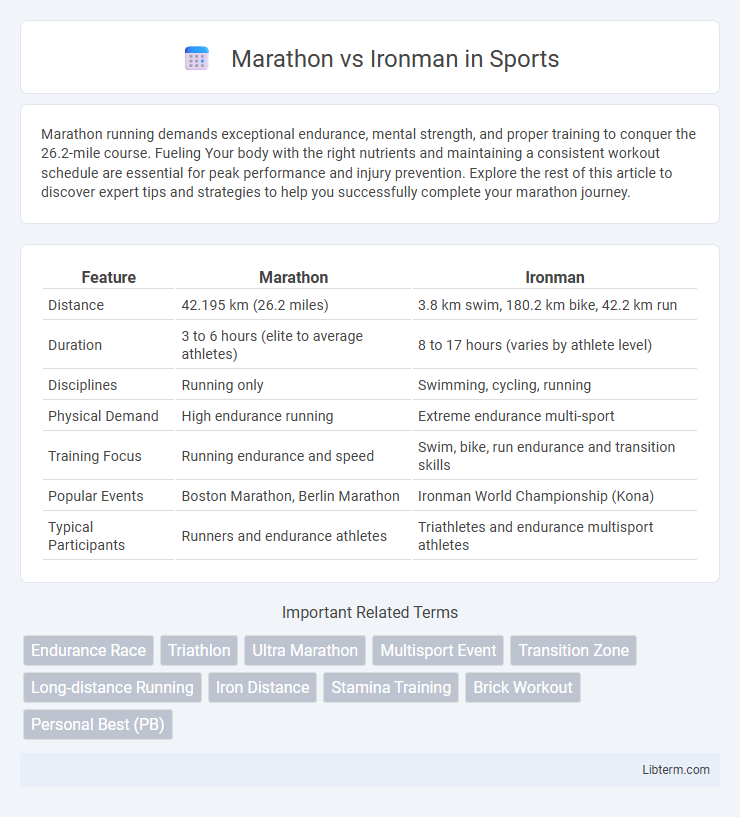Marathon running demands exceptional endurance, mental strength, and proper training to conquer the 26.2-mile course. Fueling Your body with the right nutrients and maintaining a consistent workout schedule are essential for peak performance and injury prevention. Explore the rest of this article to discover expert tips and strategies to help you successfully complete your marathon journey.
Table of Comparison
| Feature | Marathon | Ironman |
|---|---|---|
| Distance | 42.195 km (26.2 miles) | 3.8 km swim, 180.2 km bike, 42.2 km run |
| Duration | 3 to 6 hours (elite to average athletes) | 8 to 17 hours (varies by athlete level) |
| Disciplines | Running only | Swimming, cycling, running |
| Physical Demand | High endurance running | Extreme endurance multi-sport |
| Training Focus | Running endurance and speed | Swim, bike, run endurance and transition skills |
| Popular Events | Boston Marathon, Berlin Marathon | Ironman World Championship (Kona) |
| Typical Participants | Runners and endurance athletes | Triathletes and endurance multisport athletes |
Introduction to Marathon and Ironman
A marathon is a long-distance running race with an official distance of 42.195 kilometers (26.2 miles), testing endurance and speed primarily through continuous running on roads or trails. An Ironman triathlon consists of a 3.86 km swim, 180.25 km bike ride, and a full marathon run, challenging athletes' stamina across three demanding disciplines. Both events are benchmarks in endurance sports with distinct physical and mental requirements, attracting competitive and recreational participants worldwide.
Overview of Marathon Distances and Formats
Marathon races cover a standardized distance of 42.195 kilometers (26.2 miles), typically run on roads with official courses certified by athletics organizations such as World Athletics. Formats include traditional mass-participation events, time-trial races, and trail marathons, each tested for varying terrain and elevation profiles. Unlike Ironman triathlons, marathons exclusively focus on endurance running without swim or cycling segments.
What is an Ironman? Understanding the Event Structure
An Ironman triathlon consists of a 2.4-mile swim, a 112-mile bike ride, and a 26.2-mile marathon run completed consecutively. The event tests endurance across three disciplines, requiring athletes to transition quickly between swimming, cycling, and running. Unlike standalone marathons, Ironman races combine multiple sports into one grueling endurance challenge governed by the World Triathlon Corporation.
Key Differences: Marathon vs Ironman
Marathon and Ironman differ significantly in endurance demands, as a marathon consists of a 42.195 km (26.2 miles) running race, while an Ironman triathlon includes a 3.86 km swim, 180.25 km bike ride, and a full marathon run. Training intensity for an Ironman requires balanced multi-discipline preparation, emphasizing swimming, cycling, and running, whereas marathon training primarily focuses on long-distance running and pacing strategies. Recovery time and nutrition needs vary, with Ironman athletes managing prolonged energy expenditure and muscle fatigue from three sequential endurance sports, contrasting the singular physical strain of marathon running.
Training Demands: Marathon vs Ironman
Training demands for a marathon primarily focus on building running endurance, speed, and injury prevention over weeks of progressively increasing mileage. Ironman training requires a multidisciplinary approach, combining extensive swimming, cycling, and running workouts, often totaling 15-20 hours per week to develop stamina, strength, and efficient transitions. Marathon training typically spans 12-20 weeks, while Ironman preparation can extend 20-30 weeks due to its complexity and higher overall volume.
Physical and Mental Challenges Compared
Marathons demand sustained aerobic endurance and mental resilience to maintain a consistent pace across 26.2 miles, often pushing runners through physical fatigue and psychological barriers. Ironman triathlons combine 2.4 miles swimming, 112 miles cycling, and a full marathon, requiring versatile physical conditioning and heightened mental toughness to endure extended multisport stress. Both events test athletes' pain tolerance and concentration, but Ironman imposes greater complexity in energy management and strategic pacing, amplifying physical and cognitive challenges.
Typical Athlete Profiles for Each Event
Marathon athletes typically exhibit strong endurance running skills, often focusing on sustained pace over 26.2 miles, with training centered on running-specific cardiovascular fitness and muscle strength. Ironman triathletes display versatility across swimming, cycling, and running disciplines, requiring balanced endurance, muscular endurance, and efficient energy management for the 140.6-mile race. The typical marathon runner emphasizes speed and stamina within a single sport, while Ironman athletes prioritize cross-disciplinary endurance and recovery adaptability.
Time Commitment and Preparation
Training for a marathon typically requires 12 to 20 weeks with 4 to 5 days of running per week, accumulating 30 to 50 miles weekly. Ironman preparation demands a significantly higher time commitment, often 20 to 30 hours per week for 20 to 30 weeks, combining swimming, cycling, and running workouts. The multidiscipline nature of Ironman training necessitates balancing endurance, strength, and technique across three sports, making preparation far more complex and time-intensive than marathon training.
Popular Races and Event Locations
Marathon races such as the Boston Marathon and New York City Marathon attract tens of thousands of runners annually, with iconic routes through historic cityscapes. Ironman triathlons, including the Ironman World Championship in Kona, Hawaii, feature demanding courses with swimming, cycling, and running segments across diverse terrains. Both events draw international participants but cater to different endurance and multisport capabilities.
Which Event is Right for You?
Choosing between a Marathon and an Ironman depends on your fitness level, training commitment, and endurance goals. Marathon runners typically focus on 26.2 miles of running, requiring strong aerobic capacity and speed, while Ironman athletes must prepare for a 2.4-mile swim, 112-mile bike, and 26.2-mile run, demanding multi-discipline endurance and extensive training time. Assess your available training hours, experience in swimming and cycling, and personal challenge preferences to decide which endurance event aligns best with your capabilities and objectives.
Marathon Infographic

 libterm.com
libterm.com